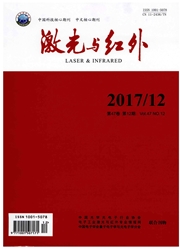

 中文摘要:
中文摘要:
为了实时检测天基平台上超远距离成像的星空背景下红外弱小运动目标,提出了一种基于时空域方向滤波和最小二乘预测的算法。首先,介绍了传统的方向滤波及时序上的双向滤波两者的频域理论推导,并经过对比说明了双向滤波的优点。接着,在双向滤波基础上,提出了一种新型方向滤波算法,并分析了新型算法在时耗方面的优势。然后,在分析新型方向滤波算法性能的基础上,说明了基于过门限率的图像分割方法。最后,介绍了最小二乘预测的理论,并给出了相应的跟踪算法。实验结果表明:目标的位置跟踪偏差平均约为1个像素,在图像大小为256×256像素的情况下,20帧图像的检测跟踪时间平均约为1.137 s。检测跟踪效果满足精度要求,检测时间也基本能满足超远距离成像红外系统的实时性要求。
 英文摘要:
英文摘要:
In order to detect the moving infrared dim targets in real-time under starry sky background,a method was proposed based on the spatio-temporal directional filter and the least square(LS) prediction.Firstly,the theoretical derivation in frequency domain of both the traditional directional filter and the bi-directional filter was introduced,and the advantages of bi-directional filter were illustrated through contrast.Then,on the basis of the bi-directional filter,a new directional filter algorithm is proposed,and the advantages of time consumption were analyzed.Secondly,after analyzing the performance of the new directional filter algorithm,the image segmentation method based on threshold rate was illustrated.Finally,the theory of LS prediction was introduced,and the corresponding tracking algorithm was given.The experimental results show that the average location deviation of object tracking is about 1 pixel,and it will take about 1.137 seconds to detect and track the image with 20 frames when the image size is 256×256 pixels.The detection and tracking results meet the requirement of precision,and the detecting time can basically meet the real-time requirement of the infrared system imaging at extreme distance.
 同期刊论文项目
同期刊论文项目
 同项目期刊论文
同项目期刊论文
 期刊信息
期刊信息
